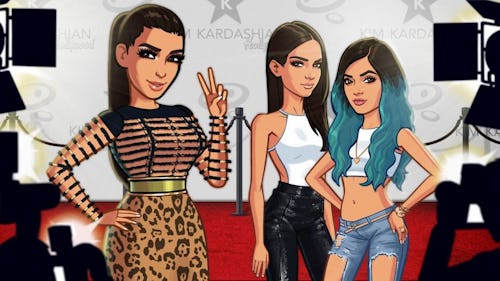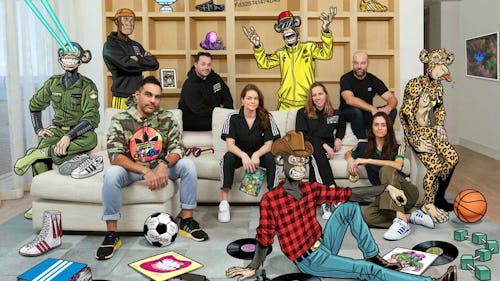
Kim Kardashian didn’t just break the internet — she practically invented it.
At least, she invented the way we use the internet today. As perhaps the original influencer, Kardashian successfully marketed herself throughout each era of the internet, so much so that she’s lost the influencer label in favor of “social media mogul.” Mere influencers aren’t modeling for Balenciaga, hosting SNL, or sitting on top of a billion-dollar shapewear company, after all.
The internet has shortened everyone’s fifteen minutes of fame, yet Kardashian is one of the few people who has remained relevant over the years: She provided content for online celebrity tabloids in Web 1.0, later producing content for herself (and her 289 million followers) on Instagram in Web 2.0. And always one step ahead of the masses, Kardashian eased into Web 3.0 long before Meta, Bored Ape Yacht Club, or mainstream fashion brands.
The Betaverse

According to fashion writer and producer Alexandra Hildreth, there is no better example for the evolving digital world than Kardashian’s Kim Kardashian: Hollywood game. Launched as an app in 2014, the game was one of the first “legitimate business opportunities for huge profit margins [within] the social media sphere,” Hildreth tells Input. It capitalized on the “perceived ability to recreate the social cache” her name carries in our society, which a bevy of loyal fans — sometimes too loyal, as ex-husband Ye demonstrates — continues to inflate.
The concept of Kim Kardashian: Hollywood revolved around fame and reputation, with players striving to increase their initial E-list rank to A-list. The game’s combination of social structure and celebrity influence — upkept by a digital wardrobe, hairstyles, and makeup — “really hit the nail on the head” as an example of how people wanted a virtual world to reinvent themselves in every aspect, says Hildreth.
By having digital proximity to Kardashian, and other stars within the game, players got “a sense of validation as if [the game] were their real life,” she adds. “It mirrored our social interactions so perfectly that many people ended up spending hundreds and even thousands of dollars on the game’s add-ons and bonuses.” There was a personal, addictive satisfaction in moving up from a C-list to a B-list celebrity — a feeling that’s currently replicated in exclusive online spaces like Bored Ape Yacht Club.

Hildreth, outside of the club looking in, deems it “all too hackable.” To her, the Bored Ape Yacht Club is simply “Club Penguin for millionaires:” Like the game, one has to afford fees in order to gain access to the online members-only group — and the more money you have, the better off you are. BAYC requires an NFT of a cartoon primate as its entry fee, with some monkeys selling for their initial $250 price and others auctioned for more than $3.4 million. Celebrities like Steph Curry, Lil Baby, Jimmy Fallon, and Post Malone all hold apes, meaning if you’re part of the club, you’re digitally rubbing shoulders with someone of prestige in the physical world. Yet in the case of BAYC, members are able to talk to other real-life people — not a simulated prompt from Kim Kardashian’s avatar.
In theory, Kim Kardashian: Hollywood shares a number of similarities with Bored Ape Yacht Club, although the latter delves less into cyber clothing and more into NFTs and blockchain technology, two relatively new concepts that Kardashian herself has yet to touch. Still, Kim’s app prepared the world to spend exorbitant amounts of money on online-only goods — an idea that seemed, frankly, bananas at the time she launched Kim Kardashian: Hollywood.
Virtual reality check
Although she makes it seem otherwise, Kardashian didn’t invent the avatar-based user experience: She learned how to make it profitable, just as she did with shapewear, skincare, and well, herself. Virtual worlds were blossoming a full decade prior to Kim Kardashian: Hollywood, back when Kardashian was still working as Paris Hilton’s personal assistant.
Social networking space IMVU launched in 2004, offering an online world where members could use 3D avatars to meet new people and play games. According to Maura Welch — Vice President of Marketing at Together Labs, the creator behind IMVU — the virtual platform is “the OG metaverse.” Plans to expand its influence are ensuring IMVU is the future of the metaverse, too.
Welch tells Input that the avatar experience currently has seven million monthly active users, a number that’s only expected to grow with Metajuice, a new business division focused on NFTs and blockchain. Members are able to buy unique, wearable NFTs for their avatars — including shoes featuring active thunder and lightning — and can buy the goods with VCOIN, a non-appreciable digital currency. Unlike the money within Kim Kardashian: Hollywood, VCOIN allows people to buy, earn, hold, and exit to real value, giving users control over their earnings.
As of now, 200,000 creators are actively earning money through IMVU, doing so by working their avatar within the online community. “Users can earn VCOIN by being a great DJ or personal shopper,” says Welch. “Then they can buy their coffee the next day with the cash they made.”
“[IMVU has] been in this game for a long time,” Welch adds, noting that this is the second virtual world she’s worked on. “To do it right, you have to understand the social fabric as well as the economy.” While creators are flocking to IMVU to make money, what ultimately draws people to the virtual space is its community. As we continue to live more digitally, people are craving authentic connections more than ever.
Online — and especially within IMVU — it’s easier for people to be their true selves, says Welch. People can express themselves through various avatars, including aliens and animals, and choose from a number of clothing styles. The creative community makes it easier for users to connect with like-minded people, or as Welch puts it, to “spread the power of friendship.” Virtual reality rooms, chat, and live events make the experience feel more real than ever.
If the product of Bored Ape Yacht Club revolves around owning a million-dollar crypto monkey, the product of IMVU is people’s experience, says Welch. “We’ve had so many marriages, relationships, and long-lasting friendships blossom on IMVU,” she adds. And with the expansion of the metaverse, IMVU seeks to make its space accessible to all. “We want to unlock the power of the metaverse for regular people,” Welch says. There’s value — both monetary and sentimental — in online worlds, and exclusivity shouldn’t keep the average person from exploring that. The metaverse may be making our lives more digital, but that doesn’t make it any less real.
Leveling up

Out in the tangible world, businesses are already blurring the line between physical and virtual spaces: Brands like New Balance, Adidas, and even Victoria’s Secret are creating digital products in hopes that they eventually translate into real-world sales, while companies like Nike and Balenciaga have incorporated gaming and virtual reality into their fashion collections. Designer Asher Levine — whose work has outfitted Lady Gaga, Beyoncé, Lil Nas X, and more — is flirting with the future too, bringing his intricate, tech-heavy styles to everyday people through virtual reality and NFTs. The metaverse is bringing “new paradigms within the fashion ecosystem” — and all ecosystems, at that — Levine told Input in an earlier interview.
Regardless of status or follower count in the “real world,” everyone will have a chance to express themselves digitally. So while Kardashian herself has “cozied up” to Balenciaga’s expanding digital universe, as Hildreth notes, the social media mogul isn’t leading the way anymore. Instead, it’s up to us to find what part of the metaverse we align with, whether that’s a space dedicated to cyber couture or our somewhat embarrassing commitment to Kim Kardashian: Hollywood (which is still free online). Just like the tangible world, the metaverse is what you make of it.
VR Week 2022 is an in-depth look at the decades-long future of VR successes, failures, and innovations to come.
More VR Week 2022 stories:
- 'Zenith' is an early access take on VR 'World of Warcraft'
- Inside the volunteer 'police department' arresting people in VR
- How one group is remaking sign language for the VR age
- Hot job alert: metaverse architect
- VR needs to address the huge motion sick elephant in the room
- The 9 best apps to get started working in VR
- Inside the volunteer 'police department' arresting people in VR
- There’s no VR internet in our future — at least not one we’d want
- The 11 best hardcore VR games you should play right now
- From ‘The Lawnmower Man’ to Meta: VR’s most important moments







